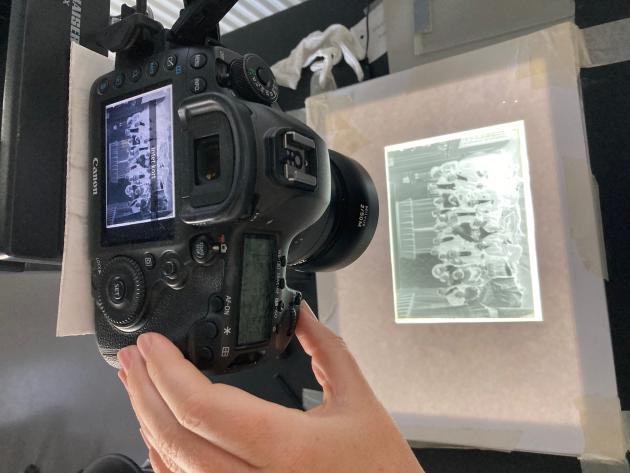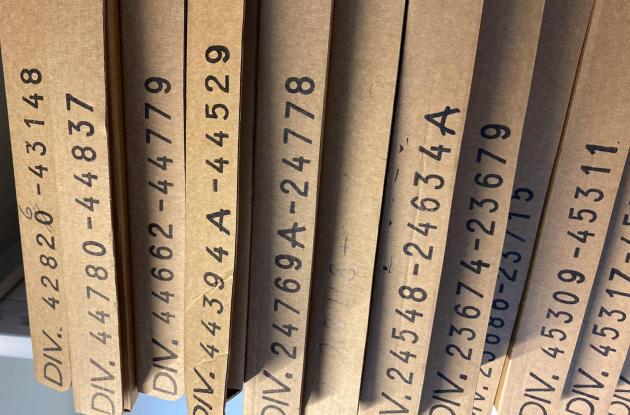About the Elfelt collection
Digitising 170,000 glass negatives is no easy task. Join us in the engine room during the digitisation of Elfelt's thousands of photographs and handwritten order protocols.
In 1982, together with the Museum of Copenhagen, the library bought the negative archive of Royal Court Photographer Peter Elfelt (1866-1931). Before this large acquisition, some of the collection had been sold. Denmark's Radio had, for example, secured film clips and what are called stereoscope photographs, which have since been handed over to Royal Danish Library. After the purchase, some remnants were also collected and purchased, and in 1991, the majority of the collection was in public hands.
The photographs were taken in the period 1890-1970. In the last part of the period – after Elfelt's death in 1931 – they were taken by the company Elfelt & Co. The collection is divided into different series.
Distribution of the collection
The main part is divided into the following negative collections
- Carte de visite photographs (negatives for portraits, where the copies were pasted on cardboard with the photographer's name)
- Cabinet card photographs (negatives for portraits, where the copies were pasted on cardboard (large size) with the photographer's name)
- The miscellaneous collection (negatives from events, street environments, businesses, institutions, et cetera)
In addition, there are a number of special collections
- Zachariae (negatives taken for manufacturing merchant Francis James Zachariae)
- Stereoscope photographs (negatives in pairs for paper photographs which, if viewed in a stereo viewer, gave a 3D effect).
- Sign photos (negatives of particularly famous people, which were put up for sale in Elfelt's display cabinet)
- Sciopticon (slides used in lectures)
- Elfelt private (negatives of Elfelt and family)
- Architecture and town plans (negatives of buildings and urban spaces)
Digitisation of 170,000 glass negatives
Royal Danish Library began digitising the collection in 2019. Digitisation is a complex task, and Elfelt's negative archive presented particular challenges. The majority of the negatives are made of glass and are very fragile. Some of the plastic negatives contain nitrates and are therefore flammable. In addition, the protocols in which Elfelt wrote down all orders and therefore contain important information are difficult to read. The challenges lined up, but after three years of steady work with expedition, material determination, digitisation and transfer of information, the collection is available and searchable in Digital Collections.

Photo: Det Kgl. Bibliotek
The first negatives were packed in blue freezer boxes and landed in the Digitisation Department in December 2019. Here, a number of photo booths were set up with a Canon SLR camera mounted above a light table. The negative was placed on the light table and then exposed. Afterwards, the file was named and edited in the software program Capture One.
At the same time, important work was carried out with Elfelt's order protocols. They say that a picture is worth a thousand words, but it is pretty handy to have names and subjects if you have to find something in the several hundred thousand pictures. The information was there in the protocols, but it took far too long to enter them. The library has worked with automatic text recognition for a long time, and it was also used here. However, it is not that easy, because the protocols are handwritten and require human effort in the Transkribus programme. A team of students therefore worked to "teach" the computer to read the protocols. It is painstaking work, but it helps to solve future tasks with reading handwriting.
Digital image files and information are added together in a management system, and when the whole thing is quality-checked and any errors have been corrected, the collection is ready to be published in Digital Collections. Here, however, the pictures lie without information about Peter Elfelt or about the time in which they were taken. You can instead read about that here in this theme on Elfelt.
We have never previously counted all the photographs in Elfelt's collection. Therefore, it was also exciting to see how many digitisations we would come up with. The collection was estimated at approximately 450,000 photographs, but we ended up launching 170,000. Of course, there are various small collections waiting to be digitised, but it will be impossible to reach over 200,000. This is how it is when you work with big data in analogue form.
Free copyright
Royal Danish Library owns the Peter Elfelt collection jointly with the Museum of Copenhagen, and both institutions are delighted to be able to digitise it. The photographs are free of copyright and posted in good resolution, so they can be used for many purposes.
Curious to know more?
Lennart Weber published "Arven efter Elfelt : Kgl. hoffotograf Peter Elfelt 1866-1931" in Danish in 2015. You can borrow it from us or from your local library.
Explore Elfelt's collections
Have you felt like exploring Peter Elfelt's thousands of photographs? In Digital Collections you can find photographs of everything from the development of the big city in 1900 to portraits, athletes and shop facades.
